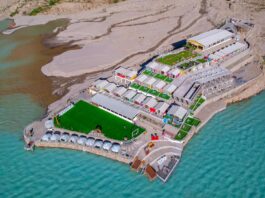Scaling-up of Glacial Lake Outburst Flood (GLOF) risk reduction in Northern Pakistan

Glacial Lake Outburst Floods
A Glacial Lake Outburst Flood, or GLOF, is sudden release of water from a lake fed by glacier melt that has formed at the side, in front, within, beneath, or on the surface of a glacier.
Due to rising temperatures, glaciers in Pakistan’s northern mountain ranges (the Hindu Kush, Himalayas and Karakorum) are melting rapidly and a total of 3,044 glacial lakes have developed in Gilgit-Baltistan (GB) and Khyber Pakhtunkhwa (KP). Of these, 33 glacial lakes have been assessed to be prone to hazardous glacial lake outburst flooding (GLOF). GLOF are sudden events which can release millions of cubic metres of water and debris, leading to the loss of lives, property and livelihoods amongst remote and impoverished mountain communities. Over 7.1 million people in GB and KP are vulnerable; in these areas, 26.7 percent and 22 percent of the population, respectively, are below the poverty line.
The Scaling-up of GLOF risk reduction in Northern Pakistan (GLOF-II) project is a continuation of the four-year ‘Reducing Risks and Vulnerabilities from GLOF in Northern Pakistan’ (GLOF-I) project. GLOF-I helped vulnerable communities prepare for and mitigate GLOF risks through early warning systems, enhanced infrastructure and community-based disaster risk management.
Mountain regions are at the front line of climate change. Disturbances in hydrology disrupt their lives. High altitudes permit only single cropping, and if there is insufficient water, the cropping season is impacted, which in turn forces the community to buy grains from the market. This is a common challenge in the community with poor households more acutely hit by water scarcity.
Life for women and men was getting more difficult by the day, and mired in a poverty trap, there was little that they could do to change their lives. The cycle of poverty was taking its toll on women and girl child education, as more girls were kept at home to help with mounting water related chores.
Reducing Glacier Lake Outburst Flood Risks in Northern Pakistan
The project will build 250 engineering structures including damns, ponds, spill ways, tree plantation and drainage to reduce risk. At the same time, the development of disaster management policies and the introduction of weather monitoring stations, flood gauges, hydrological modelling and early warning systems will increase the ability to respond rapidly to flood scenarios.
The project has an estimated lifespan of 15 years.

